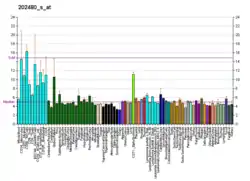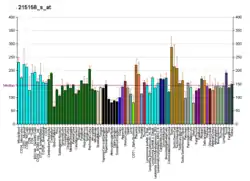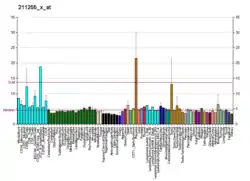Death effector domain containing protein is a protein that in humans is encoded by the DEDD gene.[5][6][7]
Function
This gene encodes a protein that contains a death effector domain (DED). DED is a protein–protein interaction domain shared by adaptors, regulators and executors of the programmed cell death pathway. Overexpression of this gene was shown to induce weak apoptosis. Upon stimulation, this protein was found to translocate from cytoplasm to nucleus and colocalize with UBTF, a basal factor required for RNA polymerase I transcription, in the nucleolus. At least three transcript variants encoding the same protein have been found for this gene.[7]
Interactions
DEDD has been shown to interact with:
References
- 1 2 3 GRCh38: Ensembl release 89: ENSG00000158796 - Ensembl, May 2017
- 1 2 3 GRCm38: Ensembl release 89: ENSMUSG00000013973 - Ensembl, May 2017
- ↑ "Human PubMed Reference:". National Center for Biotechnology Information, U.S. National Library of Medicine.
- ↑ "Mouse PubMed Reference:". National Center for Biotechnology Information, U.S. National Library of Medicine.
- 1 2 Stegh AH, Schickling O, Ehret A, Scaffidi C, Peterhänsel C, Hofmann TG, Grummt I, Krammer PH, Peter ME (Dec 1998). "DEDD, a novel death effector domain-containing protein, targeted to the nucleolus". EMBO J. 17 (20): 5974–86. doi:10.1093/emboj/17.20.5974. PMC 1170924. PMID 9774341.
- ↑ Leo CP, Hsu SY, McGee EA, Salanova M, Hsueh AJ (Dec 1998). "DEFT, a novel death effector domain-containing molecule predominantly expressed in testicular germ cells". Endocrinology. 139 (12): 4839–48. doi:10.1210/endo.139.12.6335. PMID 9832420.
- 1 2 "Entrez Gene: DEDD death effector domain containing".
- 1 2 Zhan Y, Hegde R, Srinivasula SM, Fernandes-Alnemri T, Alnemri ES (Apr 2002). "Death effector domain-containing proteins DEDD and FLAME-3 form nuclear complexes with the TFIIIC102 subunit of human transcription factor IIIC". Cell Death Differ. 9 (4): 439–47. doi:10.1038/sj.cdd.4401038. PMID 11965497.
- 1 2 Roth W, Stenner-Liewen F, Pawlowski K, Godzik A, Reed JC (Mar 2002). "Identification and characterization of DEDD2, a death effector domain-containing protein". J. Biol. Chem. 277 (9): 7501–8. doi:10.1074/jbc.M110749200. PMID 11741985.
- ↑ Stegh AH, Schickling O, Ehret A, Scaffidi C, Peterhänsel C, Hofmann TG, Grummt I, Krammer PH, Peter ME (Oct 1998). "DEDD, a novel death effector domain-containing protein, targeted to the nucleolus". EMBO J. 17 (20): 5974–86. doi:10.1093/emboj/17.20.5974. PMC 1170924. PMID 9774341.
- ↑ Alcivar A, Hu S, Tang J, Yang X (Jan 2003). "DEDD and DEDD2 associate with caspase-8/10 and signal cell death". Oncogene. 22 (2): 291–7. doi:10.1038/sj.onc.1206099. PMID 12527898.
Further reading
- Park MY, Ryu SW, Kim KD, Lim JS, Lee ZW, Kim E (2005). "Fas-associated factor-1 mediates chemotherapeutic-induced apoptosis via death effector filament formation". Int. J. Cancer. 115 (3): 412–8. doi:10.1002/ijc.20857. PMID 15688372.
- Alcivar A, Hu S, Tang J, Yang X (2003). "DEDD and DEDD2 associate with caspase-8/10 and signal cell death". Oncogene. 22 (2): 291–7. doi:10.1038/sj.onc.1206099. PMID 12527898.
- Lee JC, Schickling O, Stegh AH, Oshima RG, Dinsdale D, Cohen GM, Peter ME (2002). "DEDD regulates degradation of intermediate filaments during apoptosis". J. Cell Biol. 158 (6): 1051–66. doi:10.1083/jcb.200112124. PMC 2173221. PMID 12235123.
- Zhan Y, Hegde R, Srinivasula SM, Fernandes-Alnemri T, Alnemri ES (2002). "Death effector domain-containing proteins DEDD and FLAME-3 form nuclear complexes with the TFIIIC102 subunit of human transcription factor IIIC". Cell Death Differ. 9 (4): 439–47. doi:10.1038/sj.cdd.4401038. PMID 11965497.
- Schickling O, Stegh AH, Byrd J, Peter ME (2002). "Nuclear localization of DEDD leads to caspase-6 activation through its death effector domain and inhibition of RNA polymerase I dependent transcription". Cell Death Differ. 8 (12): 1157–68. doi:10.1038/sj.cdd.4400928. PMID 11753564.
- Roth W, Stenner-Liewen F, Pawlowski K, Godzik A, Reed JC (2002). "Identification and characterization of DEDD2, a death effector domain-containing protein". J. Biol. Chem. 277 (9): 7501–8. doi:10.1074/jbc.M110749200. PMID 11741985.
This article is issued from Wikipedia. The text is licensed under Creative Commons - Attribution - Sharealike. Additional terms may apply for the media files.






